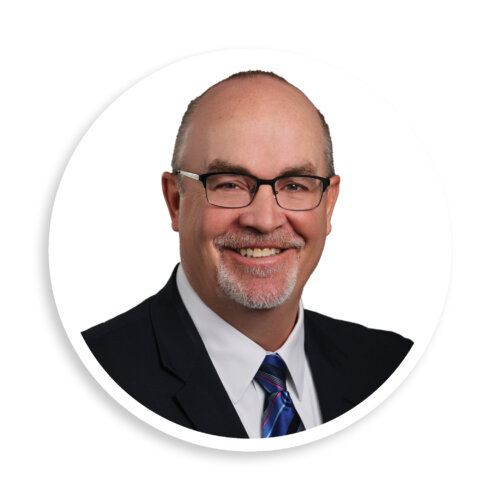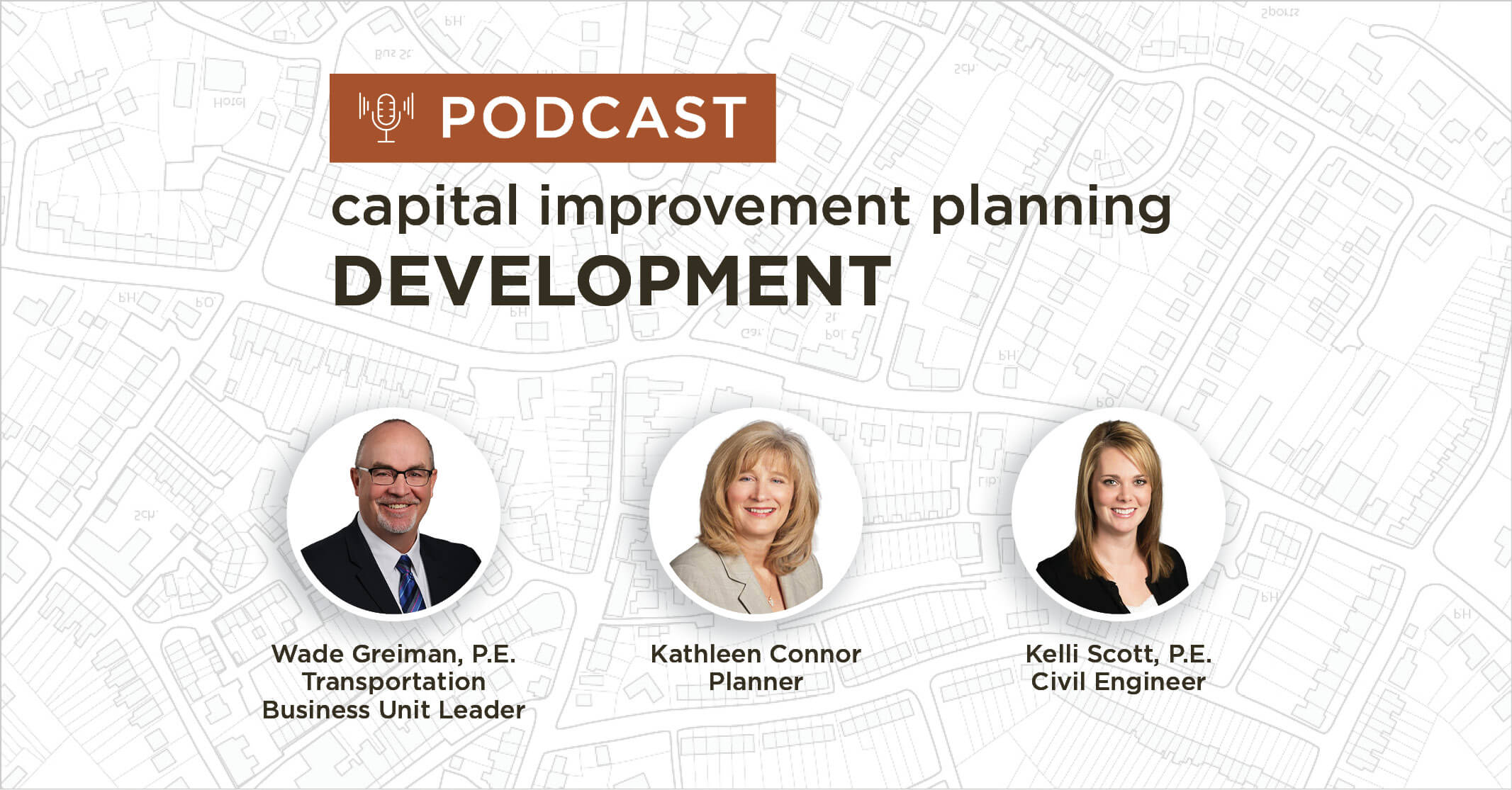Creating an Implementable Capital Improvement Plan (CIP)
Capital improvement planning is essential for communities of all shapes and sizes, from large, sprawling cities to rural farming towns. Used to organize proposed capital improvement projects and public expenditures by priority, schedule, funding and financing availability, and estimated expenses over a multi-year period.
During this podcast, Wade Greiman, P.E., Kelli Scott, P.E., and Kathleen Connor walk through the beginning stages of developing a Capital Improvement Plan. They explore best practices for gathering input from your community and how Snyder & Associates supports clients in their journey to obtaining project funding.
Podcast Agenda
- Capital Improvement Plans Require Big-Picture Thinking (0:20)
- Planning Based on Community Goals (2:58)
- Prioritizing Projects & Initiatives for Capital Improvement Plans (10:16)
- Identifying Available Funding Sources (14:04)

Wade Greiman, P.E.
Transportation Business Unit LeaderWade Greiman, P.E.
Transportation Business Unit LeaderTransportation Planning, Road & Highway Design, Environmental Compliance, Funding Procurement, Public Engagement, Traffic Studies

Kelli Scott, P.E.
Civil EngineerKelli Scott, P.E.
Civil EngineerWater/Wastewater System Planning, Design & Construction, Water Treatment Design, Municipal Engineering, Transportation Design & Construction

Kathleen Connor
PlannerKathleen Connor
PlannerMunicipal Planning & Engineering, CIPs & Assessments, Zoning & Subdivision Regs, Comp Plans
Capital Improvement Plans Require Big-Picture Thinking
Wade Greiman (0:20)
My name is Wade Greiman, and I serve as the Transportation Business Unit Leader for Snyder and Associates. With me today are Kelli Scott and Kathleen Connor. They will be sharing their insights related to developing Capital Improvement Programs for cities across Iowa. Thanks for joining me. Kathleen, as you’ve worked with multiple cities over the years, what have been some of your city’s most challenging issues to overcome when developing a realistic Capital Improvement Program?
Kathleen Connor (0:46)
One of the big issues is getting them to think big first so that they’re looking at a broad spectrum, not just water and sewer projects, for example. They’re looking at parks, they’re looking at capital expenditures such as fire trucks, and pulling all of those into a big list. Then being able to prioritize them and understand the difference between needs and wants. The other thing that I think is important is for a city to figure out how much they can spend on an annualized basis, whether they’re looking at doing a project spanning two years but yet one construction season, or if they’re looking at bonding, and how much they can pay off and borrow each year. They can then look at the projects that they want and that they need to do and know how many of those are going to fit within a five-year or even 10-year CIP and how many maybe wind up being unmet needs.
The other challenging thing is when we look at alternative funding sources so that all the projects aren’t paid out of the city’s funds. It is talking about assessments as an option. Some cities, when they see how much they need to spend on all of their projects, they are more favorably looking at assessments, but when it comes down to realistically getting an idea of – how much are you willing to assess – when the property owners are in the room, and they’re not happy about being assessed. So having a realistic discussion about assessments.
Kelli Scott (2:01)
I would agree with what Kathleen is saying. The other big hurdle that we end up having is getting people to take that step into wanting to develop a Capital Improvement Program. There are so many of the small communities that go based on, as needed. They’ve had a series of water main breaks the last winter, so next year they’re going to fix that segment of water main, or they have a street that the concrete keeps blowing out, so that’s the project for next year. It becomes more of a reactive process for them than a proactive process.
Getting them just to want to sit down and do a Capital Improvement Program has been a really big first step, and as Kathleen said, it’s not just about the water, the sewer, and the streets. Firetrucks, for example, are very expensive. So are dump trucks and snowplows. So, just planning out the fact that those don’t last forever and you don’t want to come up with that big chunk of change all at once is one of the things that we struggle with.
Capital Improvement Program Planning Based on Community Goals
Wade Greiman (2:58)
We work with varying clients that have varying levels of growth and varying levels of resources available at their fingertips to help them with the CIP process. Can you talk a little bit more about some of those details related to communities that are struggling with growth, versus communities that growth is just inherent to their daily routine, and how our services can help to set both ends of the spectrum up for success?
Kathleen Connor (3:25)
My history is typically working with rapidly growing communities, generally in the metro areas. Those communities are working hard to stay ahead of that growth and planning for staffing needs and the demands that they’re going to have with the ever-increasing infrastructure that their communities have. Trying to also stay ahead of developers so that they have a plan in place, so that what developers are proposing fits within that plan. They’re working as hard as they can to stay ahead of the growth, and that takes a lot of planning, but it takes a different kind of planning than a community that is trying to manage the resources that they have now and stretch those dollars.
Kelli Scott (4:03)
I typically work with some of the smaller communities that are either losing population or are stagnant. Some of them are further out from the Metro area, so they are growing, albeit more slowly.
It can be as simple as a list of projects, and you put them in a spreadsheet with five fiscal years out, and then it can get as complicated or complex as you want. We tailor the Capital Improvements Plans to what each community needs. It doesn’t have to be a long-drawn-out or expensive.

Public engagement sessions were used to keep property owners and other stakeholders informed.
thing. It can be an hour or two-hour meeting with the community to help them come up with a list and put together a spreadsheet, and then we go back to the office and help them put some costs together. It doesn’t have to be a weeks, months, or years drawn out process, or as much as it is nice to have public involvement, it doesn’t necessarily have to have public meetings where everybody gets their opinion, especially in some of the smaller communities where your infrastructure is all you have to spend your money on.
Where we run into that, a lot is in the smaller communities again, where the public works director, the water operator, the wastewater operator, or even the clerk have been there for 20, 30 plus years. They just know this stuff. They know where the valves are in the street. They know the project that was done 15 years ago that fixed X, Y, Z. Some of this is just documenting things that have been done or that we know that we have to do. It’s kind of like a grocery list. You put your list together of things that you need so that it doesn’t get forgotten by the current council or future council—everybody kind of knows where you’re going.
Kathleen Connor (5:43)
It’s not a one-size-fits-all in terms of the way we approach Capital Improvement Plans. It’s dependent upon the community and what its vision is.
Wade Greiman (5:53)
So really, what it is, is it’s an exercise of effective and active listening to find out what the community’s concerns are, what their limitations are, what their goals are, and then fashioning a plan and approach to their Capital Improvement Program planning process that best fits them.
In working with a city that’s about to go through the Capital Improvements Program development process or the CIP process, what are some of the documents that you might rely upon to assist them with their upcoming CIP planning work?
Kelli Scott (6:24)
Usually, if they have a comprehensive plan that they have completed at some point, we start with that. People prioritize and say what their wants and needs are. The comprehensive plan is usually a community type of process where everybody gets to come in and give their input, and then the final document comes into place, and it’s really to represent the general wants and desires of the community. That would probably be the biggest document I would say that I rely on.
Then when we’re coming up with what types of projects they should be looking at, it comes down to our experience with other communities, other projects, and issues that we’ve seen, and also sometimes it comes down to funding available. If there’s certain funding available right now, even if you’re not planning on doing the project for another two or three years, it might help out with that.
Then we look at past projects that the community has done and the current bid environment to help them come up with the actual conceptual cost estimates to go ahead and put into the CIP. That also comes back to historical data for things, like a firetruck. For example, you can say you spent $300,00 to $500,000 on that. So, let’s throw that in there and figure out how many years we want to work that out. I would say those are the biggest documents that we rely upon.
Otherwise, most of it is a conversation with the council, mayor, and clerk, as well as if you’ve gotten a lot of community complaints about things that are happening, as I said, water pressure or traffic is too fast, that sort of thing.
Kathleen Connor (8:06)
I agree that the comp plan is important, and if they built off any strategic plans off of that. Engineering studies, if you’ve done a water system analysis that tells you when you might need a new booster pump, new treatment plant, or water main upgrades. If the city has worked on any concept plans and developed order of magnitude costs, having a realistic idea of what the projects are going to cost is pretty important. If you develop a plan without being very realistic, it starts to fall apart fairly quickly.
One thing I’ve noticed is some communities do is fail to include costs for engineering. They may include construction costs without including the engineering costs and on large projects that can make a difference, as well as any costs that they might have for bond counsel or if they’re going to bond for projects. So including those engineering, administrative, and legal costs is important.
If a city has done any needs assessment analysis for its facilities. Some communities have done that where they’ve had a consultant come in and look at their city hall, library, police, and their fire departments. Particularly in a growing community where you’re continually adding staff, but not necessarily adding the space that goes along with that. Oftentimes there’ll be a needs assessment done so that they can program those in and maybe a smaller project without going to a full bond referendum for a new city hall, for example.
Wade Greiman (9:25)
So, Kathleen, you mentioned the bond council. How often are you actively engaged with them, assisting the city with statutory limits for borrowing and so forth? How does that typically go for you?
Kathleen Connor (9:38)
It depends. In some communities, we’ve done a pretty significant amount of work in that regard. Where they will look to see what their bonding capacity is and what is their bonding limit in terms of what they want to spend on capital projects. So we program it out so that we know when certain bonds are off, the same way you look at a loan being paid off and how much you can add to it each year so that their overall debt limit is not exceeded. So some communities, we go into quite a bit of detail; other communities may have their city manager or a finance director that does that type of thing. So it varies from community to community. We have the experience that we can help them to whatever level that they need.
Prioritizing Projects & Initiatives for Capital Improvement Plans
Wade Greiman (10:16)
To vet this just a little bit further, have you ever encountered a community where prioritization of those projects or initiatives, that there’s a conflict between the decision-makers, and then if so, how have you maneuvered through that in assisting the cities in helping figure out what their
priorities should be?
Kathleen Connor (10:34)
From my perspective, what we’ve done is work with communities on having goal-setting sessions. Where you have work sessions to talk through those projects and do rankings. One of the last ones we worked on there was a list of all the different kinds of projects. They were put under streets projects, water and sewer projects, some of them were new city hall or city hall remodeling type projects, so there were some facility type projects listed as well, and parks and trails projects. We gave them stickers. They only had so many stickers that they could put on that had a higher point value and then so many stickers that had lesser point values. So then, with only those stickers, people had to individually rate where they wanted to put their points and, ultimately, their dollars. Everybody got their stickers, so then it helped shake it out visually because there were different colored stickers, and you can see which projects got the most attention.
Kelli Scott (11:22)
We’ve done some of that as well. With some of the smaller communities that don’t have some sort of planning process in place already, it comes down to health, and safety is where they’re spending a lot of money. A lot of people want a new park, or new playground equipment, or something like that, but when you have a water main from 1886, those kinds of things end up taking priority just out of necessity.
People don’t like spending their money on the things that they can’t see, which is why parks, city halls, and that sort of thing tend to rank higher on people’s lists until they come up. Knowing that people are having issues in their water distribution system, lead, and copper, pressure issues, or people are having backups of their sewer into their basements – those end up taking priority because those are health and safety, and impact people a little bit more personally if your basement is flooded with sewage, then if you don’t have a new swing set. So those are on the more reactive approach. The smaller communities are more based on that versus those that do have some of the planning already in place. It goes along more with what Kathleen was saying because usually, they’re caught up with some of that basic infrastructure that they need.
Kathleen Connor (12:29)
Part of it comes down to making sure the council understands the importance of a particular project is. They may see a water main, and it’s – oh, that’s not exciting to do that project – but understanding why that is important and understanding that for each project. So that when they’re making a decision, they’re not just looking at a project name, but they do understand the justification for that project.
Kelli Scott (12:52)
I was going to touch base a little bit, too, on Kathleen’s thinking big. People get scared when you start making these lists of projects because the numbers get really big. They start focusing more on the cost and how they’re going to pay for it versus the necessity of the projects.
We try to talk to people about making your wish list of all the projects that need to be done at some point. A lot of times, the big projects, the treatment plant projects, the city hall buildings, the libraries, that sort of thing, that are multi-million dollar projects that end up getting put on the back burner because everybody knows that the dollars are so high and nobody wants to be the one that says we’re raising taxes to pay for this, we’re bonding for this, we need to get a loan for this, raising sewer rates, or that sort of thing. So a lot of times, they get scared of the dollar, and that’s not something that anybody should be scared of. It’s just a plan for the city. Once you make this plan, nothing is saying that priority number one has to be done this year; priority number two has to be done next year. It’s just bookkeeping. So you know, and everybody is aware of what is going on, and things don’t come up as surprises.
Identifying Available Funding & Financing Sources
Wade Greiman (14:04)
Specifically, Kelli, when you bring up the large numbers and the sticker shock effect, what are some of the success stories that you might have as it relates to identifying outside funding sources to help soften the blow?
Kelli Scott (14:18)
Usually, it’s the smaller communities and the less affluent communities that are eligible for the grant and loan programs. A private homeowner’s association had been having some issues with arsenic for a very long time, exceeding the limits, and they had tried to put it off as long as they could because it was only 14 homes. It was going to be several hundred thousand, to over a million dollars, to get something in place, and the DNR happened to have a loan forgiveness program as part of their State Revolving Fund (SRF) program that they were able to get 75% forgiveness to take care of their problem.
We were able to do more of a comprehensive approach that would potentially help additional communities versus just helping them. Their option was either to put a little treatment plant that just served their 14 homes, which had its issues, or put a several-mile-long water main to the property that the current developments between them had the option to connect into it. So, that’s going to open up land for the development as well, but they got that 75%, and that was what they needed to be able to afford the project. Otherwise, there was nothing to it and that had nothing to do with income. That’s a year-by-year DNR with the SRF loan program. They change that every year on what is eligible for loan forgiveness.
Some of the other communities that we’ve done; usually it’s low-income, ended up with block grant money. Usually, it’s $300,000 to $600,000, depending on your community size. But, we’ve had communities where they’ve essentially paid nothing for a project. We had a wastewater project, the plant was flooded back in 2008, and the state came out with some funding, and by the time that all that funding and the block grant were all combined, they essentially had a free wastewater treatment plant.
The reason for the improvement in every community is different, but there’s always something we can look at. Not always successful, but there’s always places that we can go and look. We’re always on the lookout for new programs, and we’re more than willing to take a long shot and put together the one or two-page application for anybody interested at no cost just to help them get things going.
Kathleen Connor (16:32)
On an entirely different track, but in terms of looking at how do you make those big dollars more appealing or more manageable, I guess, is looking at how you could phase projects. We worked with a community that had parkland dedicated for development, and the parkland itself had sat with nothing happening for years and years, and the neighbors were complaining that they weren’t getting the park. We looked at the cost of full development of the park, which was more than the city could absorb in their CIP, given their other needs. We helped them break it down into a phased project. So, the first thing that they did was, we’re going to be doing a trail that connected that park to the Neil Smith trail so that they had regional connectivity. Just that one improvement made the neighbors feel better that they had something going on and a plan in place. Then they can do small pieces of the project as time goes on, instead of waiting until you can do everything all at once.
Wade Greiman (17:26)
So Kathleen and Kelli, thank you so much for joining me today. For those listening in, we invite you to join us again, as we will be discussing the various planning efforts that go into creating a resilient community and potential funding sources available to accomplish your goals. Thank you.

